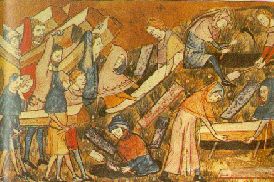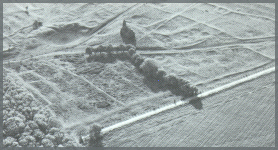
Did people in the Middle Ages have the same diseases that we have today? By examining skeletons, archaeologists can tell how old the person was when they died, and sometimes what they died of as well. It seems that only one out of every ten adults lived to be as old as fifty. Many babies, children and teenagers died. Common diseases were dysentery, malaria, diphtheria, flu, typhoid, smallpox and leprosy. Most of these are now rare in Britain, but some diseases, like cancer and heart disease, are more common in modern times than they were in the Middle Ages.
There were regular waves of 'pestilence' or plague throughout the Middle Ages, but in 1348/9 an illness came to Britain that killed more people, even the young, strong and healthy, than ever before. It came into Europe from the East, carried by the fleas that lived on black rats. Its signs were a fever, a terrible thirst, and dark blotches under the skin. It was from these that the disease got its name - The Black Death. Almost half the population of Britain died of it - that is, nearly one and a half million people.

Burying the dead
Whole villages were wiped out by the disease, or the surviving inhabitants fled. In many villages there was no one left to till the fields, and famine soon followed, killing or driving out those who were left. You can still see the sites of some of these deserted villages today.

The deserted village of Cottam in Yorkshire
No one knew what caused the disease, and Medieval medicine was powerless against it. People felt hopeless and afraid. They thought the Black Death epidemic was a sign that God was angry with them.